This Is the Best Way to See the Grand Canyon
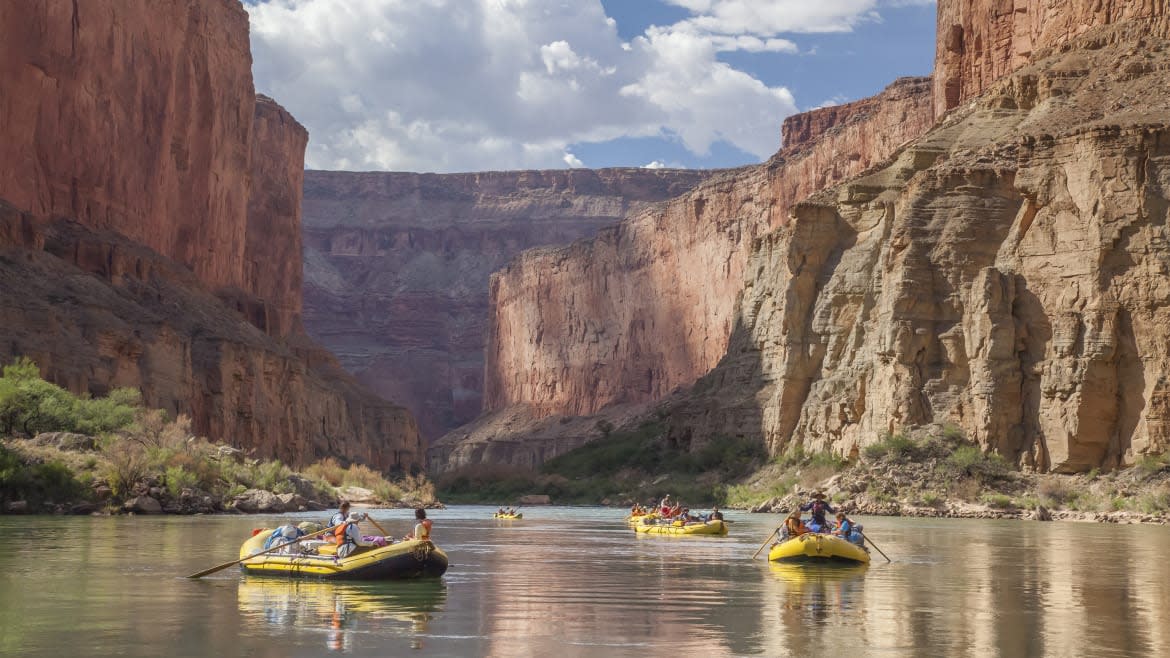
My first visit to the Grand Canyon last year was fairly typical. I rented a car, drove through the park’s main entrance, stayed in a park hotel for two nights (not one of the fancy ones, unfortunately), and never left the South Rim. Though I’m an avid hiker, I visited a few days after a snowstorm so the popular trails down into the canyon were icier than I was in the mood for. Instead, I opted to hike the 13-mile trail that runs along the canyon’s southern rim.
The park’s visitor center and car-friendly checkpoints along the road bordering the rim were crowded with people but I ran into almost no one during my hikes. For the majority of my two days of rim hiking, I felt like I had the southern rim of the canyon all to myself. When you think of iconic images of the Grand Canyon, you’re thinking of the view from the top of the South Rim, where the canyon’s incredible depth and immense scale are breathtaking and almost unbelievable. In my opinion, the view from the South Rim was, and still is, the most magnificent view I’ve ever seen anywhere in the world in my entire life.
Virtually every single rafting guide I’ve ever had from Wyoming to West Virginia has told me that the stretch of the Colorado River that runs through the Grand Canyon is the most sought-after series of rapids in the entire country and that anyone who loves rafting needs to do it. Somehow, despite hiking the entire trail along the South Rim and visiting every single scenic viewpoint, I never even saw the Colorado River. Where was it? And, more importantly, how could I get to it?
The Colorado River winds its way through the Grand Canyon, cutting through hundreds of miles of steep canyon walls that are so enormous that the river typically isn’t even visible from the rim. As stunning as the view of the Grand Canyon is from the top of the canyon, it gives absolutely no clues to what’s hidden along, behind, and inside the walls of the canyon. Seeing the Grand Canyon from the top of the rim is kind of like entering Machu Picchu but turning around at the entrance. Sure, the view is stunning but it’s only a small fraction of what’s around the corner. A quick trip to the Grand Canyon’s South Rim, or even a hike down into the canyon along one of its popular trails, simply does not do it justice.
Of the nearly 5 million annual visitors the Grand Canyon receives, only about 27,000 take the river route. Certainly, more rafters would hit the river were it not for the park’s strict but necessary visitor caps and permit lottery, the most coveted rafting permit in the entire country. Most Grand Canyon rafting trips, be they commercial or privately-organized, are 8-14 days long; winter trips can last an additional week, as there are fewer boats on the river, more campsites available, and shorter days mean you cover less ground (water) each day. And while an 8-14-day trip is nowhere near long enough to explore this enormous wilderness, a rafting adventure offers a unique window into America’s grandest natural treasure.
What impressed me the most about the trip was the diversity of the landscape, which slowly unfolded as we paddled our way downstream for two weeks. Every single day, we were confronted with astounding beauty that was completely different from what we had encountered on previous days. Every day was different. Every hike was distinct. Every canyon was unique. Every rapid was its own.
We spent most of each day on our boats but river paddling was broken up by hikes, nature walks, and mini adventures. Side trips range from 10-minutes to several hours and all are optional so you can sit them out if you’re tired or simply not interested. Some hikes were long and steep, leading to the remnants of dwellings and granaries where ancient Puebloans stored and sealed their food. Other hikes visited small waterfalls, large waterfalls, slot canyons, and amphitheater-like rock formations. In some cases, hikes were simple and straightforward while others required us to walk through streams, scramble across boulders and slippery cliffs, and butt slide, stem, or spider jump our way across narrow canyons where the water was too deep to wade. Some of these moves were a first for me so I sat out the first few before finally climbing (quite literally) outside my comfort zone to butt slide my way to a hidden waterfall. My shoulders were tired for two days but I felt like a ninja warrior.
My personal favorite hike, Deer Creek Falls, was a steep, challenging trek that required us to hold on to a rock shelf as we slid sideways along a narrow rock ledge that plummeted down to a small river feeding into the Colorado (this particular hike is not for anyone with a fear of heights). Those of us brave enough to complete the trek saw petrified worms clinging to the bottom of rock ledges and Native American hand prints painted on the canyon walls. Eventually, the narrow, winding path opened up to a desert-like oasis, where we swam in small waterfalls and had lunch under towering trees that provided some much-needed shade in the midday sun and 95-degree heat.
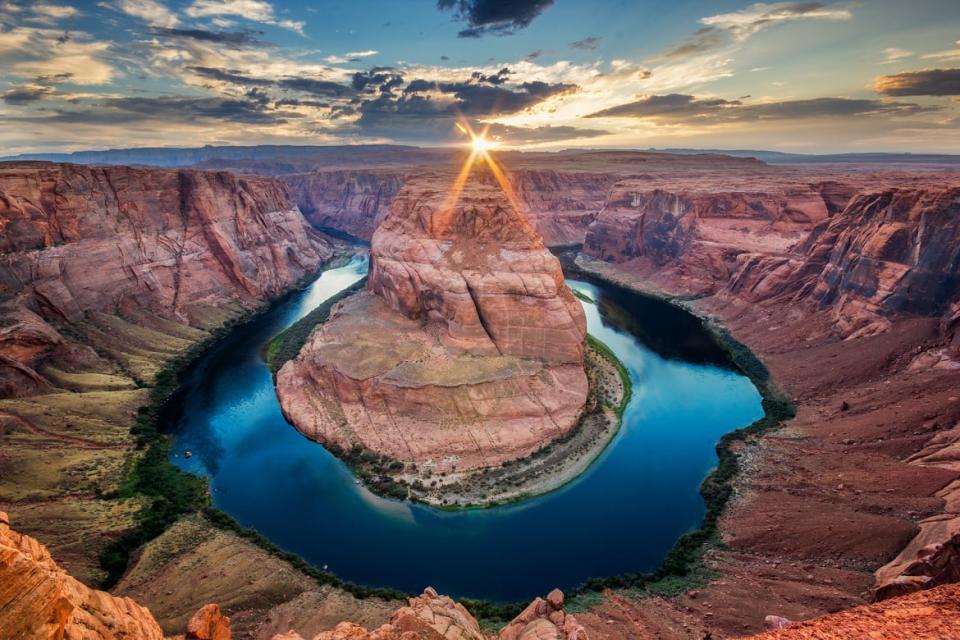
The Horseshoe Bend at sunset.
The Upper Canyon
River rafting trips through the Grand Canyon are divided between the Upper and Lower sections of the canyon. If you don’t have the time, money, or interest in rafting the full stretch, you can do either the upper (the first 6-7 days of a 14-day trip) or the lower (the last 9-10 days). After the raft put-in location at Lee’s Ferry (near famed Horseshoe Bend), the first take-out location isn’t for another 225 miles so if you want to raft just the upper or the lower section of the river, you’re going to have to hike in or out of the canyon (more on that later). If you’re fancy, there are also companies that will fly you in or out on a helicopter half way down the river.
The advantage of upper canyon rafting trips is that you see the layers of the canyon slowly unfolding, growing about 40 feet per day for the first 100 miles, exposing different layers of rock as they push themselves up to the sky. You learn the history of the early explorers and rag tag group of adventurers who made the first ever recorded river run through the canyon, hungry, nearly-naked, and frustrated by the endless number of disasters and repairs the boats needed. You learn about dams that have been built (and prevented from being built) in the canyon, how they have impacted the environment, and how the entire region has been suffering from a years-long drought that many believe will lead to serious water wars in the future.
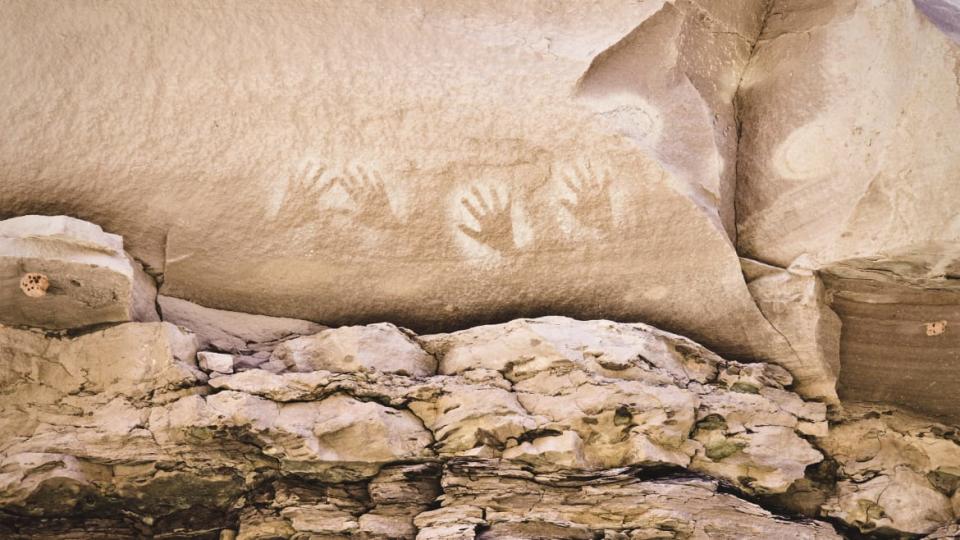
Anasazi handprints above Deer Creek Falls.
You see where different Native American tribes lived, visit archeological sites and remnants of their societies, and learn about the ideal conditions that all tribes were seeking: clear water, good soil, and access to the rim. You learn how the National Parks Service pushed tribes out of the canyon and even burned their villages to make way for what is now Grand Canyon National Park, where many Indigenous people were then forced to labor in the early days. (I am the Grand Canyon is a great book about the story of the Havasupai people and their struggle to regain their traditional land in the canyon). The upper river trip is the perfect introduction to the Grand Canyon and its long and complicated history.
The Lower Canyon
The main advantage to a lower canyon rafting trip is that you get 9-10 days on the river, compared to the 6-7 days included on upper canyon trips. Since you’re starting in the middle of the canyon, you get to the raft by hiking down Bright Angel trail (accompanied by a guide), which is a bit less strenuous than the hike up and out of the canyon that the upper canyon rafters make. Whether you’re hiking in or out of the canyon, know that it is a steep, 7.5-mile trail that is especially challenging during the sweltering summer months.
While beauty is in the eye of the beholder, most of my rafting guides told me that they believe the lower canyon is more beautiful than the upper. I have to agree with them, as the lower canyon has more waterfalls, unique rock formations, and wild hikes that I found more interesting and impressive. Despite believing the lower canyon is more beautiful, my guides said that for anyone who can’t do the full canyon, they recommend first-timers choose the upper section so they learn more of the canyon’s history and see how the rock layers develop and change. Not that these expert river runners need me to back them up, but I also agree with them on that point.
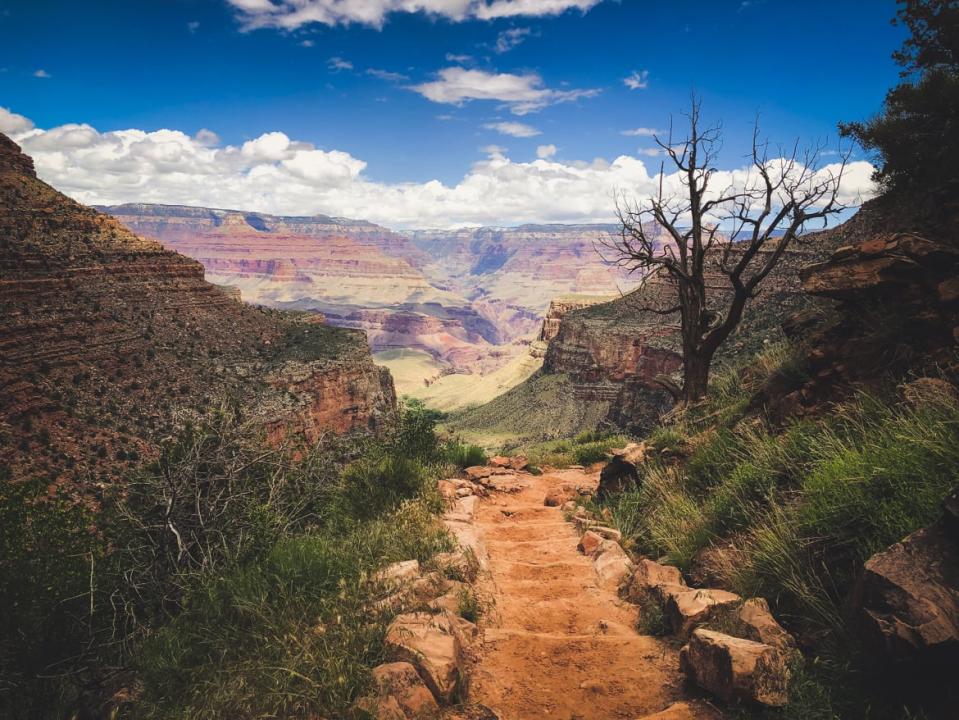
The Bright Angel Trail.
Choosing Which Rafting Trip to Take
I went with Arizona Raft Adventures, who I can’t recommend enough. The pre-trip information was clear and well-organized, the guides were phenomenal, and the food was fabulous. Last winter, I signed up for their 8-day motorized rafting trip because every single paddle trip was sold out. Considering paddle trips typically sell out 1-2 years in advance, this wasn’t surprising but it was disappointing since I really wanted to paddle.
Lucky for me, my repeated calls to the company to see if anyone had dropped out of upcoming paddle trips proved successful and I snagged a seat on an August all-paddle adventure at the last minute. Side note: as nervous as I was to visit Arizona in August, I later learned that August is the state’s monsoon season (yes, apparently, that’s a thing), so August is actually slightly cooler than June and July. The downside? Rain pushes loads of sediment into the river so it looks like chocolate milk instead of liquid emerald and turquoise. So much for my attempt at #NationalParks social media fame.
Personally, I wasn’t that excited about the motorized trip because 1) I love to paddle, 2) I wanted a longer trip, and 3) I hate hearing motors when I’m in the wilderness. That said, motor trips are very popular and they are absolutely perfect for some travelers.
If you are the sort of person that takes the train and bus to reach Machu Picchu instead of hiking, then you might be better off on a motorized trip. There’s no shame in taking trains, buses, or motorized boats but it’s important to know your preferences and limitations so you don’t pick the wrong trip and spend a lot of money to be miserable. Even if you do a motor trip (which includes no paddling), you’ll still learn the fascinating history of the canyon and have the opportunity to hike, swim, scramble, and explore.
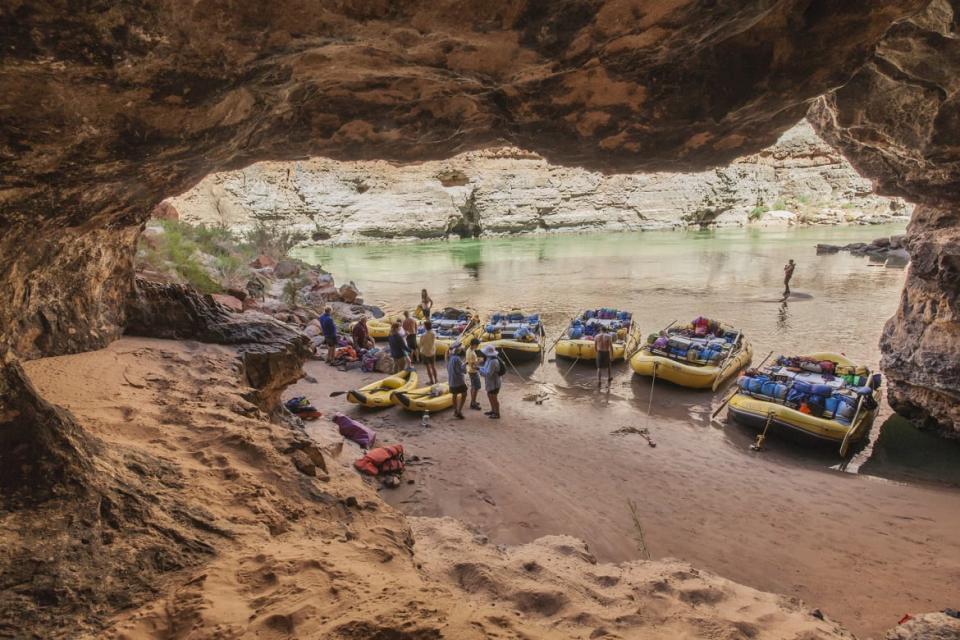
Rafters at Red Wall Cavern on the Colorado River in Grand Canyon National Park.
Motor trips are shorter than most paddle trips (typically 8 days instead of 14), which makes them cheaper and easier. After all, sleeping on the ground, getting bit by bugs, and pooping in buckets is easier to endure for 8 days than 14. Motor trips tend to be a good option for travelers with a smaller budget, physical limitations that prevent them from paddling, or anyone who can’t get two weeks of vacation (but who doesn’t want to have to hike in/out of the canyon for a shorter paddling trip). Motor trips also work well for families because they allow kids as young as 10 and they’re a good option for anyone who wants to ride in a larger boat that they’re less likely to fall out of. Who are motor trips not good for? People who want to paddle but don’t want to listen to motors and kids. Me, essentially.
If you are really into paddling and rugged adventures, then the 14-day all-paddle adventure may be right for you. If you’re somewhere in the middle, consider joining a classic paddle trip, which allows you to paddle some days and relax in the non-paddle boats other days.
Know What You’re Getting Yourself Into
Last summer, I did a 5-day rafting and camping trip along Idaho’s Salmon River with Confluences River Expeditions. It was my first multi-day rafting trip and I learned that, while I don’t sleep well because camping and buckets are not my preferred bathroom setup, I thoroughly loved the trip and knew I wanted to go on a longer trip. As usual, several of my guides on that trip told me I had to raft the Grand Canyon and they recommended the longest trip possible.
Over the course of my Grand Canyon rafting trip, I was shocked to learn that not only had many of the participants never been rafting, but some had never even been camping. If you are going to embark on a 14-day rafting and camping trip in a rugged, wilderness environment, you may want to consider getting a bit of practice first to know if this is even the sort of experience you would enjoy. Several people on the trip would have left on day 5 or 6 if they could and I’m not surprised. Rafting the Grand Canyon is not for everyone, in large part because 8-14 days of camping is not for everyone. It takes a toll on your body, it’s uncomfortable, you never have complete privacy, and there’s a lot of small inconveniences and annoying little bugs. Is it worth it? To me it was, and to the thousands of rafters who do it every year it is, but for some people, it’s just not their style of adventure.
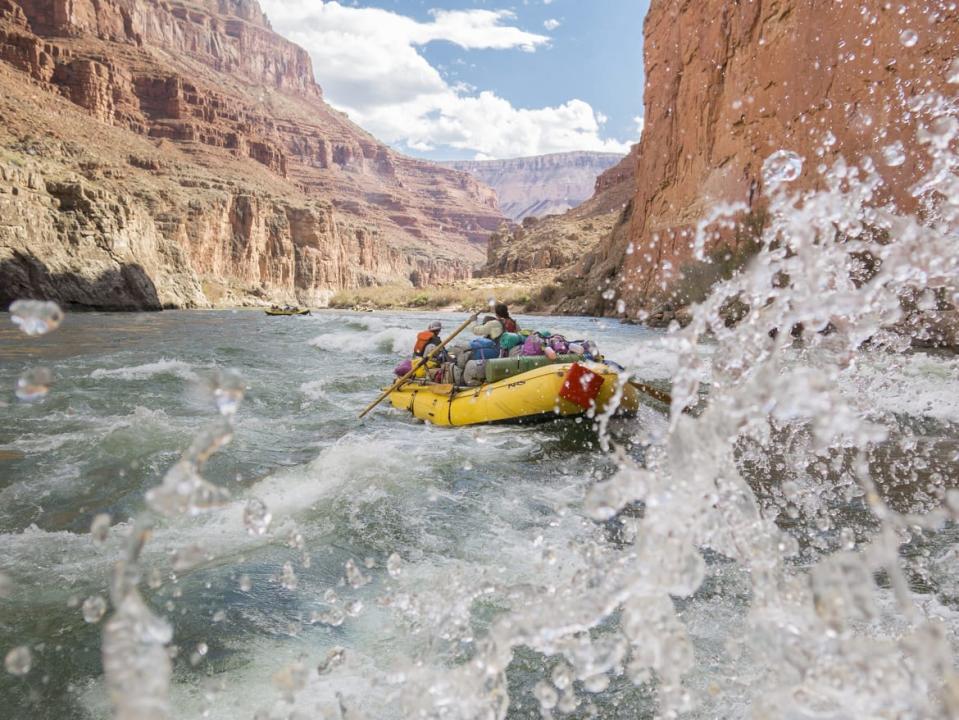
Rafters go through whitewater rapids on the Colorado River.
Flagstaff
About 90 minutes south of Grand Canyon National Park is Flagstaff, Arizona, a small and sweet town with an impressive selection of attractions, good restaurants, and hotels at all price points. You’ll likely have to come here at least one day before your rafting trip starts since this is where most rafting outfitters hold their pre-trip orientation the night before the launch. Flagstaff is worth spending a few additional days, whether you use it as a base for a day trip to the South Rim of the Grand Canyon (well worth your time), or for exploring lesser-visited attractions.
About 15 minutes from Flagstaff is Walnut Canyon National Monument, where you can hike trails and visit cliff dwellings of the Native people archeologists call Sinagua, who lived here 800 years ago. My personal favorite was Wupatki National Monument, where the exposed red rock and the remains of ancient pueblos are scattered across miles of prairie; the self-guided walking tour was fascinating but I actually spent most of my time exploring the information-dense visitor center exhibits. Sunset Crater National Monument is between Wupatki and Flagstaff so you could visit both on the same trip.
Flagstaff is also home to the Lowell Observatory, where Pluto was discovered and where NASA astronomers made a giant moon map to plot where the Apollo astronomers would touch down in the 1960s. The city has a beautiful Arboretum, a fascinating Museum of Northern Arizona (which focuses heavily on Native American history, culture, and influence), and a fun audio walking tour along Route 66, which is lined with microbreweries, street art, and historic buildings. If you like bookstores, and may want to purchase half a dozen Grand Canyon-themed books like I did, head to Bright Side Bookstore, which is a couple blocks from the Route 66 route. My first trip to Flagstaff was only one day long so for this trip, I arrived three days early so I’d have time to really explore the city. I like it so much that my family and I are considering a trip here next year (not during monsoon season).
Pro tip: The Flagstaff airport is tiny so you can arrive 45 minutes before your flight and breeze through security. It’s way easier than driving or bussing it to/from Phoenix. If you do fly in or out of Phoenix and drive to Flagstaff, (as I did for this last trip), Montezuma Castle National Monument and its five stories of well-preserved cliff dwellings are right off the highway.
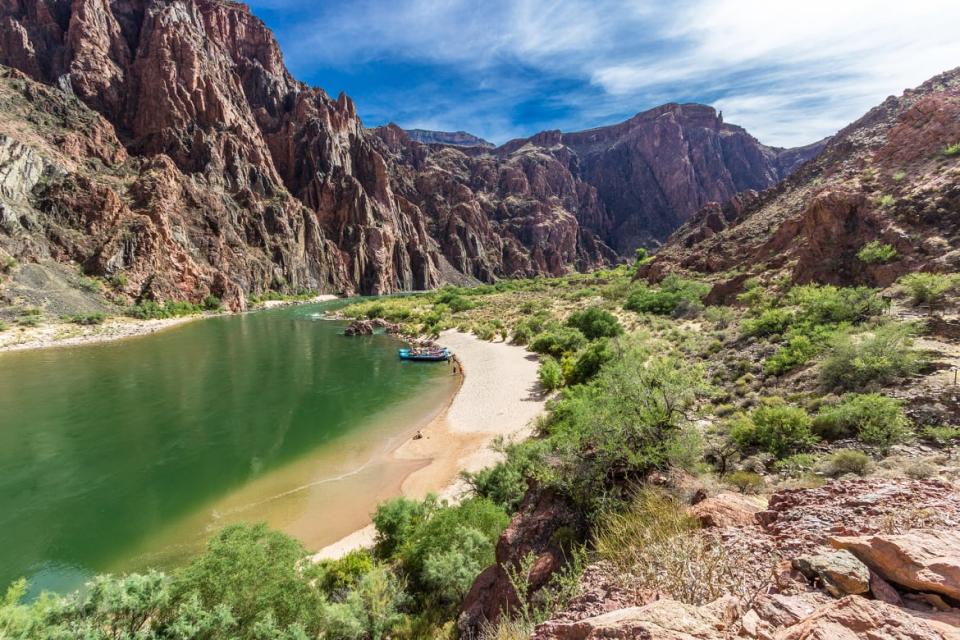
Rafters on a beach on the Colorado River in the Grand Canyon at the bottom of the South Kaibab Trail.
What to Pack
First and foremost, check with your tour operator about what you should bring on the trip. They typically provide your tent, sleeping pad, and sleeping bag, but you have the option to bring your own. I tried to be fancy and bring all my high-tech, ultralight Big Agnes camping gear but it was so dang hot at night that I wound up sleeping without a tent or bag all but one night. Also, while mosquitos aren’t really a problem here, biting ants and flies are so you’ll definitely want to bring some bug repellent. I use Ranger Ready repellent, which is made with picaridin, which one of my guides recommended as being a safe and effective alternative to DEET.
Space is limited on the raft so you’ll have to be selective with what you bring and you’ll definitely want to prioritize items that will hold up well and keep you comfortable for two weeks. For me, I opted to bring a Bear mini pillow, which took up more space than my usual inflatable camping pillow but allowed me to rest far better than I normally do while camping. I’m a very sensitive sleeper so I also brought ear plugs and an eye mask.
As an avid hiker, I already have loads of outdoorsy clothes that worked perfectly on this trip but you don’t necessarily need to buy all new gear. I mostly wore a mix of Black Diamond hiking shirts, Outdoor Vitals sun hoodies, and yoga pants but others on the trip were happy in hiking pants, gym shorts, and even nursing scrubs. High-tech, lightweight fabrics dry quickly and help keep you cool but just having all your skin covered is the priority. If you get hot, you can jump in the river. During the cooler months of September-May, you’ll likely be required to also wear a waterproof dry suit, which is provided by your outfitter.
As for footwear, you can get by in many types of sandals or water shoes but if you plan to hike, make sure you bring something with a good grip. Though I did pack proper hiking boots, I never used them since I’m accustomed to hiking in sandals. In order to prevent my feet from getting burned and having to apply sunscreen a million times per day, I wore fitness socks under my sandals, which were comfy, protective, and dried quickly (Swiftwick now even makes a Grand Canyon version of the socks).
I can’t see two feet in front of me without my glasses so I brought along three pairs because I was paranoid about losing them in the rapids. I wear fancypants Roka eyeglasses and sunglasses, which are designed for high-activity lifestyles and are less likely to slip around and fall off (they also don’t fog up easily like other glasses). That said, there’s no glasses on Earth designed to survive canyon rapids so even if you wear $10 glasses, you’ll want to buy eyewear retainers (Chums is a really popular brand).
The Grand Canyon truly is a national treasure and the Colorado River is one of the greatest rivers in the world. Whether you fly into Phoenix of Flagstaff, book a motorized trip or a paddle adventure, the canyon is calling and the best way to explore it is on a raft.
Cassandra Brooklyn is a writer, travel expert, and group tour leader. She runs EscapingNY, an off-the-beaten-path travel company, and is the author of the guidebook Cuba by Bike.
Get the Daily Beast's biggest scoops and scandals delivered right to your inbox. Sign up now.
Stay informed and gain unlimited access to the Daily Beast's unmatched reporting. Subscribe now.

